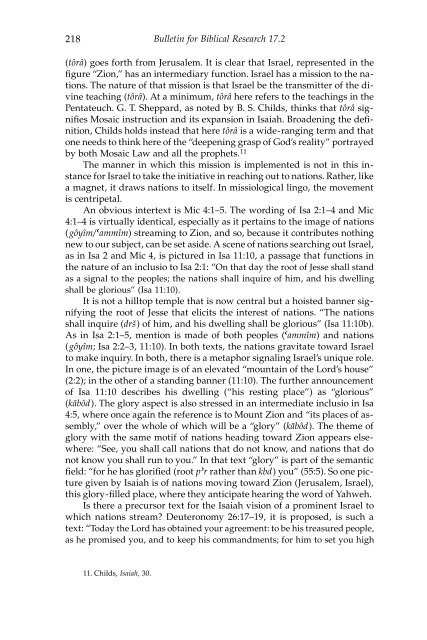Impulses to Mission in Isaiah - Institute for Biblical Research
Impulses to Mission in Isaiah - Institute for Biblical Research
Impulses to Mission in Isaiah - Institute for Biblical Research
Create successful ePaper yourself
Turn your PDF publications into a flip-book with our unique Google optimized e-Paper software.
218<br />
Bullet<strong>in</strong> <strong>for</strong> <strong>Biblical</strong> <strong>Research</strong> 17.2<br />
(tôrâ) goes <strong>for</strong>th from Jerusalem. It is clear that Israel, represented <strong>in</strong> the<br />
figure “Zion,” has an <strong>in</strong>termediary function. Israel has a mission <strong>to</strong> the nations.<br />
The nature of that mission is that Israel be the transmitter of the div<strong>in</strong>e<br />
teach<strong>in</strong>g (tôrâ). At a m<strong>in</strong>imum, tôrâ here refers <strong>to</strong> the teach<strong>in</strong>gs <strong>in</strong> the<br />
Pentateuch. G. T. Sheppard, as noted by B. S. Childs, th<strong>in</strong>ks that tôrâ signifies<br />
Mosaic <strong>in</strong>struction and its expansion <strong>in</strong> <strong>Isaiah</strong>. Broaden<strong>in</strong>g the def<strong>in</strong>ition,<br />
Childs holds <strong>in</strong>stead that here tôrâ is a wide-rang<strong>in</strong>g term and that<br />
one needs <strong>to</strong> th<strong>in</strong>k here of the “deepen<strong>in</strong>g grasp of God’s reality” portrayed<br />
by both Mosaic Law and all the prophets. 11<br />
The manner <strong>in</strong> which this mission is implemented is not <strong>in</strong> this <strong>in</strong>stance<br />
<strong>for</strong> Israel <strong>to</strong> take the <strong>in</strong>itiative <strong>in</strong> reach<strong>in</strong>g out <strong>to</strong> nations. Rather, like<br />
a magnet, it draws nations <strong>to</strong> itself. In missiological l<strong>in</strong>go, the movement<br />
is centripetal.<br />
An obvious <strong>in</strong>tertext is Mic 4:1–5. The word<strong>in</strong>g of Isa 2:1–4 and Mic<br />
4:1–4 is virtually identical, especially as it perta<strong>in</strong>s <strong>to</strong> the image of nations<br />
(gôyîm/ºammîm) stream<strong>in</strong>g <strong>to</strong> Zion, and so, because it contributes noth<strong>in</strong>g<br />
new <strong>to</strong> our subject, can be set aside. A scene of nations search<strong>in</strong>g out Israel,<br />
as <strong>in</strong> Isa 2 and Mic 4, is pictured <strong>in</strong> Isa 11:10, a passage that functions <strong>in</strong><br />
the nature of an <strong>in</strong>clusio <strong>to</strong> Isa 2:1: “On that day the root of Jesse shall stand<br />
as a signal <strong>to</strong> the peoples; the nations shall <strong>in</strong>quire of him, and his dwell<strong>in</strong>g<br />
shall be glorious” (Isa 11:10).<br />
It is not a hill<strong>to</strong>p temple that is now central but a hoisted banner signify<strong>in</strong>g<br />
the root of Jesse that elicits the <strong>in</strong>terest of nations. “The nations<br />
shall <strong>in</strong>quire (drs) of him, and his dwell<strong>in</strong>g shall be glorious” (Isa 11:10b).<br />
As <strong>in</strong> Isa 2:1–5, mention is made of both peoples (ºammîm) and nations<br />
(gôyîm; Isa 2:2–3, 11:10). In both texts, the nations gravitate <strong>to</strong>ward Israel<br />
<strong>to</strong> make <strong>in</strong>quiry. In both, there is a metaphor signal<strong>in</strong>g Israel’s unique role.<br />
In one, the picture image is of an elevated “mounta<strong>in</strong> of the Lord’s house”<br />
(2:2); <strong>in</strong> the other of a stand<strong>in</strong>g banner (11:10). The further announcement<br />
of Isa 11:10 describes his dwell<strong>in</strong>g (“his rest<strong>in</strong>g place”) as “glorious”<br />
(kabôd). The glory aspect is also stressed <strong>in</strong> an <strong>in</strong>termediate <strong>in</strong>clusio <strong>in</strong> Isa<br />
4:5, where once aga<strong>in</strong> the reference is <strong>to</strong> Mount Zion and “its places of assembly,”<br />
over the whole of which will be a “glory” (kabôd). The theme of<br />
glory with the same motif of nations head<strong>in</strong>g <strong>to</strong>ward Zion appears elsewhere:<br />
“See, you shall call nations that do not know, and nations that do<br />
not know you shall run <strong>to</strong> you.” In that text “glory” is part of the semantic<br />
field: “<strong>for</strong> he has glorified (root pªr rather than kbd) you” (55:5). So one picture<br />
given by <strong>Isaiah</strong> is of nations mov<strong>in</strong>g <strong>to</strong>ward Zion (Jerusalem, Israel),<br />
this glory-filled place, where they anticipate hear<strong>in</strong>g the word of Yahweh.<br />
Is there a precursor text <strong>for</strong> the <strong>Isaiah</strong> vision of a prom<strong>in</strong>ent Israel <strong>to</strong><br />
which nations stream? Deuteronomy 26:17–19, it is proposed, is such a<br />
text: “Today the Lord has obta<strong>in</strong>ed your agreement: <strong>to</strong> be his treasured people,<br />
as he promised you, and <strong>to</strong> keep his commandments; <strong>for</strong> him <strong>to</strong> set you high<br />
11. Childs, <strong>Isaiah</strong>, 30.

















